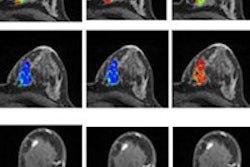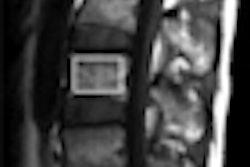BOSTON - By measuring plasma volume in spine tumors with dynamic contrast-enhanced (DCE) MRI, physicians can better assess treatment response even when conventional MRI results show little regression after successful radiosurgery, according to a study presented on Monday at the American Society for Radiation Oncology (ASTRO) meeting.
The researchers from Memorial Sloan-Kettering Cancer Center in New York City also concluded that plasma volume was the only significant variable that could accurately predict local recurrence or control of a lesion in the spine.
"This is clinically relevant because we now have tools that not only look at the actual anatomy or size of the lesion inside the spine, but also look at what is going on inside the tumor after high-dose radiation," said lead study author Dr. Yoshiya Yamada from the center's department of radiation oncology.
The study evaluated 19 patients who received both pre- and post-treatment contrast-enhanced MRI scans. Images were acquired on a 1.5-tesla MRI system (GE Healthcare) with an eight-channel spine coil. At least two follow-up MRI scans were performed on all 19 individuals at a median time of 17 months, ranging from eight to 48 months.
Fourteen of the 19 patients received a standard dose of 2,400 cGy during stereotactic radiosurgery. Seventeen individuals were later found to have locally controlled tumors, while two patients experienced local tumor recurrence.
For the purposes of this study, Yamada and colleagues determined poor treatment results through radiographic evidence of tumor progression on MR angiography, CT, or PET/CT imaging.
In their analysis of contrast-enhanced MR images, the researchers found that a mean plasma volume reduction of 66% in tumors was associated with control of spine tumor growth after treatment. The blood-flow decrease in tumors ranged from 21% to 99%.
By comparison, plasma volume increased from a low of 145% to a high of 207% in cases of recurring tumors.
Based on the results, Yamada and colleagues concluded that plasma volume was significantly associated with tumor response. In addition, DCE-MRI can suggest treatment response even when conventional MRI studies demonstrate minimal or no regression after successful spine stereotactic radiotherapy, they noted.
Yamada said that this study is the first clinical experience to confirm their work in preclinical animal models. Additional research must be done to confirm these findings among a larger patient population, he added.
|
Study disclosures Among Yamada's affiliations, he has served as a consultant for Varian Medical Systems. |



















